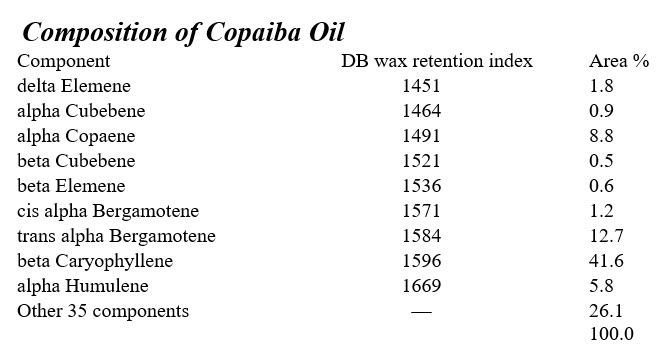COPAIBA OIL
The large wild tree Copaifera sp. of which there are several species, grows in Brazil and other Countries in the northern part of South America. The natural oleoresin flows from cavities which are made in the trees trunk. The balsam is sometimes hazy due to the presence of water and/or resinified material.
Copaiba balsam odour is faint, slightly woody and peppery and only moderately tenacious. The main components are sesquiterpene hydrocarbons, principally beta Caryophyllene, but include Copaenes, Bergamotenes, Cubebenes and Elemenes.

beta Caryophyllene

Copaiba Resinoid is a brown viscous liquid with a mild-woody, spicy odour which is moderately long lasting.
Copaiba Resinol retains the odour and performance characteristics of the balsam in a clear, mobile pale brown extract which makes it more applicable than the balsam as a modifier and blender, to light coloured soaps and toiletries. It is used in detergent and industrial fragrances.
Copaiba oil is a clear colourless oil which is high vacuum distilled directly from the balsam. The optimum conditions use the minimum of heat necessary to complete the processing, in the minimum “still” residence time. This oil captures all of the fruity. spicy character of the balsam in an alcohol soluble form which is ideal for incorporation into cologne formulations.
4 Applications
Fragrances: The copaibas do find some use in fragrances, but are not particularly good fixatives. They are blenders and modifiers that are best used where they can harmonise with ylang, heliotropine, vanillin, the ionones etc. They are used in pine, woody, sweet floral and spice fragrances where their low cost offers some advantages to the creative perfumer in lower cost formulations.
Flavours: The bitter and slightly irritating flavour of Copaiba do not make it a popular ingredient.
Flavours and Fragrances
edited by A D Swift
Google Books
